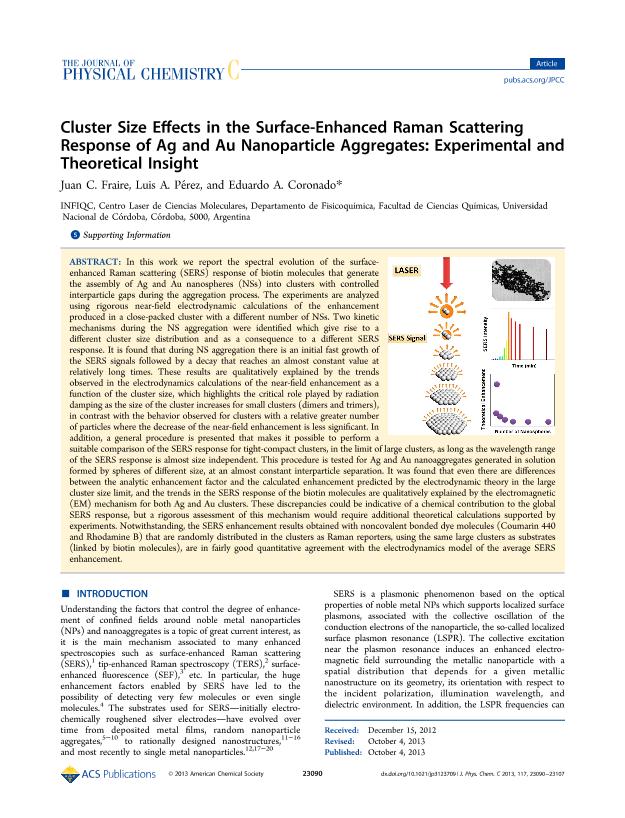Artículo
Cluster size Effects in the surface-enhanced Raman scattering response of Ag and Au nanoparticle aggregates: experimental and theoretical insight
Fecha de publicación:
10/2013
Editorial:
American Chemical Society
Revista:
Journal of Physical Chemistry C
ISSN:
1932-7447
Idioma:
Inglés
Tipo de recurso:
Artículo publicado
Clasificación temática:
Resumen
In this work we report the spectral evolution of the surface-enhanced Raman scattering (SERS) response of biotin molecules that generate the assembly of Ag and Au nanospheres (NSs) into clusters with controlled interparticle gaps during the aggregation process. The experiments are analyzed using rigorous near-field electrodynamic calculations of the enhancement produced in a close-packed cluster with a different number of NSs. Two kinetic mechanisms during the NS aggregation were identified which give rise to a different cluster size distribution and as a consequence to a different SERS response. It is found that during NS aggregation there is an initial fast growth of the SERS signals followed by a decay that reaches an almost constant value at relatively long times. These results are qualitatively explained by the trends observed in the electrodynamics calculations of the near-field enhancement as a function of the cluster size, which highlights the critical role played by radiation damping as the size of the cluster increases for small clusters (dimers and trimers), in contrast with the behavior observed for clusters with a relative greater number of particles where the decrease of the near-field enhancement is less significant. In addition, a general procedure is presented that makes it possible to perform a suitable comparison of the SERS response for tight-compact clusters, in the limit of large clusters, as long as the wavelength range of the SERS response is almost size independent. This procedure is tested for Ag and Au nanoaggregates generated in solution formed by spheres of different size, at an almost constant interparticle separation. It was found that even there are differences between the analytic enhancement factor and the calculated enhancement predicted by the electrodynamic theory in the large cluster size limit, and the trends in the SERS response of the biotin molecules are qualitatively explained by the electromagnetic (EM) mechanism for both Ag and Au clusters. These discrepancies could be indicative of a chemical contribution to the global SERS response, but a rigorous assessment of this mechanism would require additional theoretical calculations supported by experiments. Notwithstanding, the SERS enhancement results obtained with noncovalent bonded dye molecules (Coumarin 440 and Rhodamine B) that are randomly distributed in the clusters as Raman reporters, using the same large clusters as substrates (linked by biotin molecules), are in fairly good quantitative agreement with the electrodynamics model of the average SERS enhancement.
Palabras clave:
Plasmonics
,
Sers
,
Au Nanoparticles Aggregates
,
Optical Properties
Archivos asociados
Licencia
Identificadores
Colecciones
Articulos(INFIQC)
Articulos de INST.DE INVESTIGACIONES EN FISICO- QUIMICA DE CORDOBA
Articulos de INST.DE INVESTIGACIONES EN FISICO- QUIMICA DE CORDOBA
Citación
Fraire, Juan Carlos; Pérez, Luis Alberto; Coronado, Eduardo A.; Cluster size Effects in the surface-enhanced Raman scattering response of Ag and Au nanoparticle aggregates: experimental and theoretical insight; American Chemical Society; Journal of Physical Chemistry C; 117; 44; 10-2013; 23090-23107
Compartir
Altmétricas




